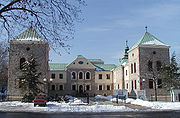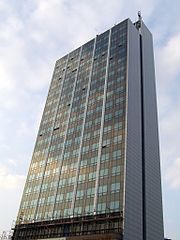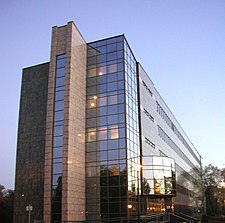| Sosnowiec | |||
|---|---|---|---|
| Sosnowiec train station | |||
|
|||
[[file:Template:Location map Silesian Voivodeship|250px|Sosnowiec is located in Template:Location map Silesian Voivodeship]]
<div style="position: absolute; top: Expression error: Unrecognized punctuation character "[".%; left: Expression error: Unrecognized punctuation character "[".%; height: 0; width: 0; margin: 0; padding: 0;"> [[File:Template:Location map Silesian Voivodeship|6x6px|Sosnowiec|link=|alt=]] Sosnowiec |
|||
| Country | |||
| Voivodeship | Template:Country data Silesian Voivodeship | ||
| County | city county | ||
| Town rights | 1902 | ||
| Government | |||
| • Mayor | Arkadiusz Chęciński | ||
| Area | |||
| • City | 91.06 km2 (35.16 sq mi) | ||
| Elevation | 250 m (820 ft) | ||
| Population (31 December 2018) | |||
| • City | 202,036 |
||
| • Urban | 2,746,000 | ||
| • Metro | 4,620,624 | ||
| Time zone | CET (UTC+1) | ||
| • Summer (DST) | CEST (UTC+2) | ||
| Postal code | 41-200 to 41-225 | ||
| Area code(s) | +48 32 | ||
| Car plates | SO | ||
| Website | http://www.sosnowiec.pl | ||
Sosnowiec (UK /sɒsˈnɒvjɛts/,[2] US /ʔˈnɔːvʔ,_ʔˈnoʊvʔ/,[3][4] Polish: [sɔsˈnɔvjɛts] ( listen)) is an industrial city county in the Dąbrowa Basin (Zagłębie Dąbrowskie) of southern Poland, in the Silesian Voivodeship , which is also part of the Silesian Metropolis municipal association.[5] Located in the eastern part of the Upper Silesian Industrial Region, Sosnowiec is one of the cities of the Katowice urban area, which is a conurbation with the overall population of 2.7 million people; as well as the greater Upper Silesian metropolitan area populated by about 5.3 million people.[6] The population of the city is 202,036 as of December 2018.[1]
Geography[]
It is believed that the name Sosnowiec originates from the Polish word sosna, referring to the pine forests growing in the area prior to 1830. The village was originally known as Sosnowice. Other variations of the name include Sosnowietz, Sosnowitz, Sosnovitz (Yiddish), Sosnovyts, Sosnowyts, Sosnovytz, Sosnowytz, and Sosnovetz. There are five other smaller settlements in Poland also called Sosnowiec, located in the Kielce Voivodship, Łódź Voivodship, and Opole Voivodship.

Sosnowiec within the Silesian Metropolis, 2012.[5]
Sosnowiec serves as one of the administrative centres of the geographical and historical area of southern Poland known as the Zagłębie Dąbrowskie (the Dąbrowa Basin). It lays within the historic Lesser Poland region near the border with Silesia. It is located about 10 km (6.2 mi) north-east to the centre of Katowice and 65 km (40 mi) north-west of Kraków, situated in the Silesian Upland on the rivers Brynica and Przemsza, a tributary of the Vistula. The full list of rivers includes Biała Przemsza as well as Czarna Przemsza, Brynica, Bobrek, and Potok Zagórski creek. The city is part of the Silesian Voivodeship since its formation in 1999. Previously (since 1945), it was part of Katowice Voivodeship, and before World War II, Sosnowiec belonged to Kielce Voivodeship.
History[]

Sielecki Castle
The history of the city in its proper sense begins in 1902 when it was granted city rights by merging a number of settlements often several centuries old. However, the history of the village of Sosnowiec dates back to the year 1227, when it was mentioned for the first time. It then was a small settlement in the Polish Duchy of Kraków, located in close vicinity of much larger and better developed villages of Sielce and Zagórze (both are now districts of the city). Other districts are even older. Milowice was first mentioned in 1123 as Miley. Documents from 1228 already mention Milowice, Klimontów, and Zagórze. Furthermore, Milowice was placed on a 1561 map.
As part of the Polish–Lithuanian Commonwealth, Sosnowiec belonged to Kraków Voivodeship, one of three voivodeships of Lesser Poland. It became a border town after the neighbouring Duchies of Silesia passed to the Bohemian Crown in 1335. In result of the Third partition of Poland in 1795, however, it was seized by the Kingdom of Prussia and was included into the newly established province of New Silesia. During the Napoleonic Wars, it became part of the Duchy of Warsaw in 1807 and later, of Congress Poland ruled by the namiestniks of the Russian Empire. Located at the borders with the German Empire and Austria-Hungary, Sosnowiec became famous for the Three Emperors' Corner tripoint, which was located within current limits of the city.
City rights[]

St. Joachim's Church
With effect from 10 June 1902, by the order of Emperor Nicholas II of Russia, Sosnowiec was legally named a city with the area of 19 square kilometres (7 sq mi) and with 60,000 inhabitants. Obtaining the city rights helped the dynamic economic and cultural development of the town. Apart from steelworks and coal-mines and many enterprises of heavy and light industry, new cultural and social establishments were opened as well. The newly established town consisted of the districts of Sosnowiec, Pogoń, Ostra Górka, Sielec, Kuźnica and Radocha, all of which had been separate villages before. The very fact that Russian authorities waited for so long to grant Sosnowiec town rights is seen as a consequence of the Polish January Uprising 1863/64, after which numerous towns had seen their status reduced to a village. Sosnowiec was first post-1860s location in Congress Poland to have received town charter, second was Puławy in 1906.
Natural resources and the good geographical location had an important influence on the development of Sosnowiec. The opening of a branch line of the Warsaw-Vienna Railway in 1859 was vitally important for the growth of the town. Development of industry with the new factory of rope and wire, rolling mill, steelworks, iron foundry, steam boilers factory, and later spinning mill, dye-house and paper mill sealed the new image of the town as entirely urban. The Summer Theatre and, in 1887, the Winter Theatre were founded, the second of which was called City Theatre from 1924 in independent Poland, and later the Theatre of Zagłębie. In 1914, the village of Środula was incorporated into Sosnowiec.
Modern era[]

Schön Palace in Sosnowiec
In the Second Polish Republic, Sosnowiec became part of the Kielce Voivodeship, and in 1934 the City County of Sosnowiec was established. Sosnowiec suffered war damages during both major military conflicts in the 20th century: World War I, which caused mainly destruction to industry, and World War II, which brought about the terror of executions.
After the 1939 Invasion of Poland, the city was occupied by Nazi Germany and renamed Sosnowitz. Initially under military administration set up as part of the General Government, Sosnowiec was annexed by Germany and incorporated into the Province of Silesia on 20 November 1939. In June 1943 thousands of Jews were deported from Sosnowiec Ghetto to Auschwitz concentration camp. The ghetto was liquidated two months later and almost all remaining Jews (around 15,000) were also deported to Auschwitz. Previously there had been considerable underground activity among them. The Vistula–Oder Offensive of the Red Army in January 1945 brought about the liberation of the city, which gave it a chance for gradual rebuilding and further development.
Post-war[]
After World War II, Sosnowiec further developed. On June 1, 1975, the metropolitan area was expanded when the neighbouring locations of Zagórze, Kazimierz Górniczy, Porąbka, Klimontów, and Maczki, became its districts. By 1977 the population of the city reached 200,000. Further growth was accelerated by the construction of Katowice Steelworks, and in 1981, the population of Sosnowiec was 250,000, reaching its peak in 1987, when it was 259,000. Since then, the population has been declining. In 1992, the city became seat of the Roman Catholic Diocese of Sosnowiec.
Parks and gardens[]
Sosnowiec has more than 2,250 ha of green areas occurring as parks, squares, protection zones, lot gardens and forests. In the area of the city preserved many parks established at the residence of industrialists, and also created a lot of new. Many of them present historical and natural value. Main parks and green areas include the Sielecki Park, which is a historical park at the castle with many natural monuments; the historical Dietel Park; the Park-Palace Complex of Schöen with two palaces; the Millennium Park, the Środula Park with a sport complex; the nature park "Szopienice-Borki"; as well as the peatbog "Bory" protected area, part of Natura 2000.
Economy[]

Faculty of Earth Science, University of Silesia
Sosnowiec is characterised by its urban dynamics, economic activity, cultural heritage, and natural environment. In recent years, Sosnowiec was further developed from an industrial centre (with mainly mining and heavy industries) into a hub of trade and services. Nevertheless, it still operates several important coal mines, steel factories and other industrial plants. Its Special Economic Zone, established in Sosnowiec thanks to the efforts of local authorities, plays a major role in attracting new businesses into the area. As a result, several companies with Polish and foreign capital opened their businesses in the city. Sosnowiec City Office was awarded the ISO 9001 2001 quality certificate for its management system for providing services for the local community.
From 2006, a new trade centre Expo Silesia began hosting numerous trade shows. Activities of Artistic and Literary Society of Zagłębie Dąbrowskie prove also that Sosnowiec as an industrial centre is not only a working class environment.
Districts[]
For Sosnowiec's 100th birthday, the downtown area was thoroughly rebuilt, to harmonise its architectural layout and give the city a more modern image. In 2004 Sosnowiec authorities and designers were awarded the Grand Prix for the rebuilding of the downtown area in a competition for the best public space in the Śląskie Provinces. This investment had been accompanied by a program designed to improve the esthetic qualities of the city, under which a comprehensive program for unifying the colors of the elevations, and advertisements entitled “rainbow city” were introduced. Among the city districts there are:
|
|
|
Points of interest[]
There are many relics of the industrial era, especially residences of industrialists. Most of them are located outside strict city center, on the Czarna Przemsza river bank. One of the oldest is a 17th-century castle known as the Sielecki Castle. Other main tourist attractions include:
- The Dietel Palace
- Schöen Palace and museum
- Oskar Schöen's Palace called also New Schöen Palace
- Wilhelm Palace
- Cathedral Basilica of the Assumption of the Blessed Virgin Mary
- Orthodox Church of the Holy Virgin, Hope, Luby and their mother Zofia
- St. John Evangelical Church
- St Thomas Church
- Railway Station Sosnowiec Główny
- Railway Station Sosnowiec Maczki
- Huta Buczek
- Old Jewish cemetery
- Three Emperors' Corner
Education and Science[]

University of Silesia in Katowice - Faculty of Computer and Materials Science
Sosnowiec is an academic centre with well-developed research and educational infrastructure on top of industry, services and trade. Its own institutions of higher learning include:
- The University of Silesia in Katowice (schools of modern languages, natural science, technology and a language teacher training college)
- Faculty of Earth Science
- Faculty of Computer and Materials Science
- Faculty of Philology
- The Medical University of Silesia in Katowice,
- Faculty of Pharmacy
- The private School of Marketing and Management
- The Silesian University of Technology
- Faculty of Automatic Control, Electronics and Computer Science
- The private School of Ecology
Among general secondary level schools in Sosnowiec there are high-schools such as the II Liceum Ogólnokształcące im. Emilii Plater, III Liceum Ogólnokształcące im. Bolesława Prusa, and IV Liceum Ogólnokształcące im. Stanisława Staszica.
Sports[]
- Zagłębie Sosnowiec: men's football team; Polish Cup winner: 1962, 1963, 1977, 1978
- KP Polska Energia Sosnowiec - men's volleyball team playing in Polish Volleyball League (Polska Liga Siatkówki, PLS), 5th place in season 2003/2004.
- kks czarni sosnowiec (Ekstraliga).
International relations[]
Sosnowiec is twinned with:
|
Notable residents[]
- Paula Kania (born 1992), Polish tennis player
- Edward Gierek (1913–2001), Polish communist politician; first secretary of the ruling Polish United Workers' Party (PZPR)
- Jędrzej Giertych (1903–1992), Polish politician
- Paul Godwin (1902–1982), Polish-German violinist
- Haim Hefer (1925–2012), Israeli poet and songwriter
- Jan Kiepura (1902–1966), Polish singer and actor
- Joanna Krupa (born 1979), Polish-American model, actress and animal rights activist
- Jacek Majchrowski (born 1947), Polish politician and historian
- Magdalena Piekorz (born 1974), Polish film director and screenwriter
- Shlomo Chanoch Rabinowicz (1882–1942), fourth and last Rebbe of the Radomsk Hasidic dynasty[7]
- Władysław Spiegelman (1906–1982), father of Art Spiegelman
- James Spigelman (born 1946), Australian judge who served as Chief Justice of New South Wales from 1998 to 2011
- Władysław Szpilman (1911–2000), Polish pianist and classical composer, widely known as the central figure in the 2002 Roman Polanski film The Pianist
- Shlomo Sztencl (1884–1919), Polish Orthodox Jewish rabbi[8]
- Ignaz von Szyszylowicz (1857–1910), Polish botanist
References[]
- ^ a b "Local Data Bank". Statistics Poland. https://bdl.stat.gov.pl/BDL/dane/teryt/jednostka. Retrieved 1 June 2019. Data for territorial unit 2475000.
- ^ "Sosnowiec". Lexico UK Dictionary. Oxford University Press. https://www.lexico.com/definition/Sosnowiec.
- ^ "Sosnowiec". Boston: Houghton Mifflin Harcourt. https://www.ahdictionary.com/word/search.html?q=Sosnowiec.
- ^ "Sosnowiec". Merriam-Webster Dictionary. https://www.merriam-webster.com/dictionary/Sosnowiec. Retrieved 2 August 2019.
- ^ a b Szymon Pifczyk (April 4, 2017). "Silesian Metropolis. The bill has been passed. Why it matters?". Wyborcza.pl. http://biqdata.wyborcza.pl/biqdata/7,159116,22156800,metropolia-slaska-ustawa-metropolitalna-przyjeta-czemu-to.html. "W połowie marca parlament przegłosował ustawę metropolitalną dla konurbacji katowickiej. Nowy twór - metropolia śląska, nie ma jednego centrum; rolę takich centrów odgrywają Katowice, Gliwice i Sosnowiec. Topografia metropolii śląskiej (z Sosnowcem włącznie) jest pokazana na mapie. Zwróć się do poradni gdy masz kłopoty ze wzrokiem."
—— (2017-04-13) "USTAWA z dnia 9 marca 2017 r. o związku metropolitalnym w województwie śląskim, pod nazwą Górnośląsko-Zagłębiowska Metropolia. Pozytywna opinia Wojewody". Dz.U. 2017 poz. 730: 1–12. - ^ European Spatial Planning Observation Network (ESPON) Study on Urban Functions. ESPON project 1.4.3; April 2007, pp. 93–94. "Upper Silesian polycentric metropolitan area. Inside the Katowice morphological area, the main municipalities are Katowice (338), Sosnowiec (240), Gliwice (208), Bytom (200), Zabrze (196), Ruda Slaska (153), Tychy (130), Dabrowa Gornicza (130), and Chorzow (120). Nine other municipalities have less than 100,000 inhabitants."
- ^ Tannenbaum, Rabbi Gershon (7 April 2009). "Radomsker Rebbe's Yahrzeit". The Jewish Press. Archived from the original on 15 June 2012. https://web.archive.org/web/20120615210441/http://www.jewishpressads.com/printArticle.cfm?contentid=38878. Retrieved 9 January 2012.
- ^ Gashury, Me'ir Shymon (1974). The Book of Sosnowiec and the Surrounding Region in Zaglebie. 1. Tel Aviv: Sosnowiec Societies in Israel and the United States, France and other countries. p. 142. http://www.jewishgen.org/yizkor/Sosnowiec/Sosnowiec.html.
External links[]
- Official web site of Sosnowiec
- Sosnowiec on an old photography (in Polish)
- Local weather in Sosnowiec, Weather.com
- Mapquest link to 6 towns in Poland called Sosnowiec
- Encarta map of Sosnowiec, Śląskie, Poland
- Pictures of Sosnowiec (in Polish)
- Jewish Community in Sosnowiec on Virtual Shtetl
- Yizkor book of Sosnowiec
- Note about Haim Hefer (1925–2012) (in Hebrew)
- Sosnowiec, Poland at JewishGen
| |||||
|



